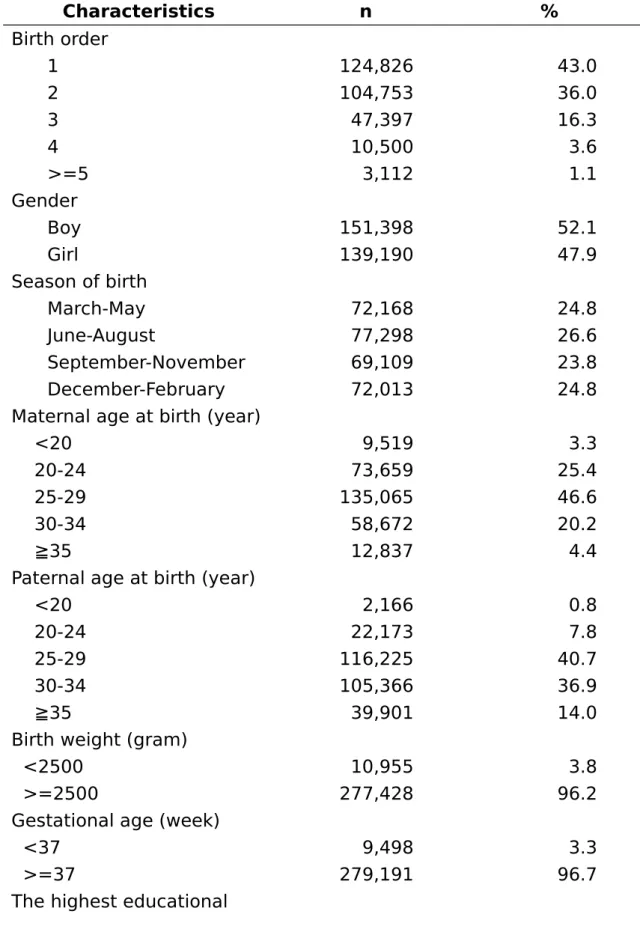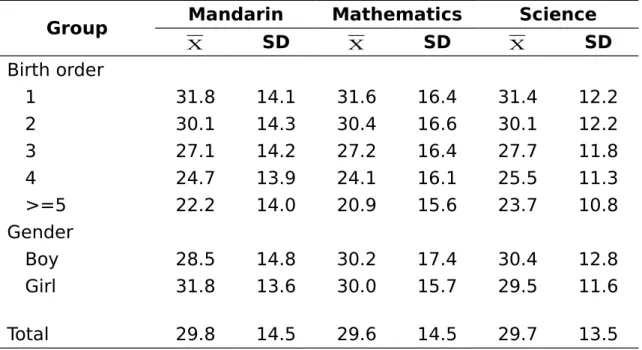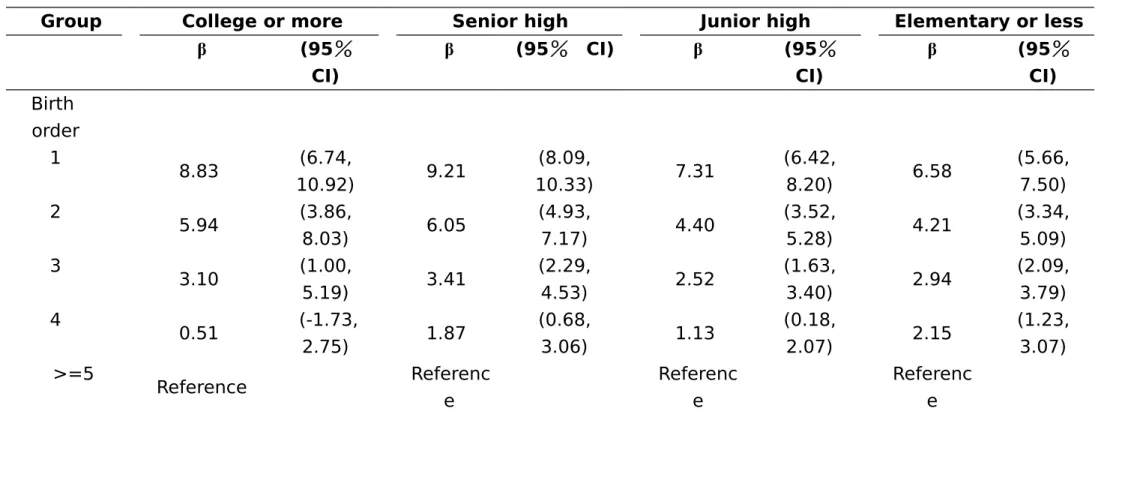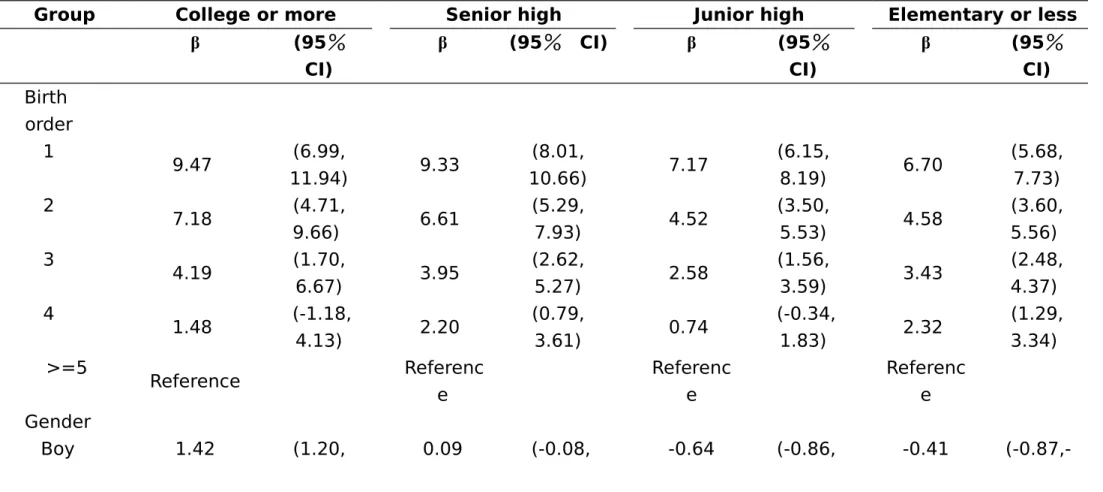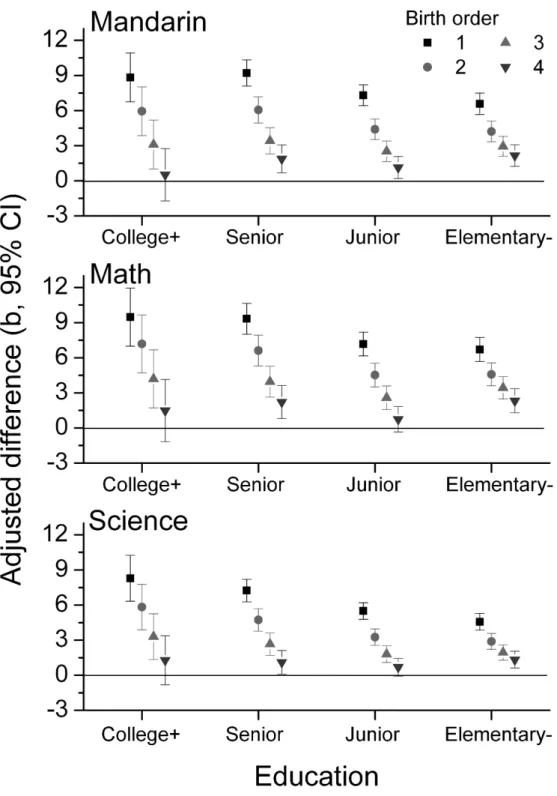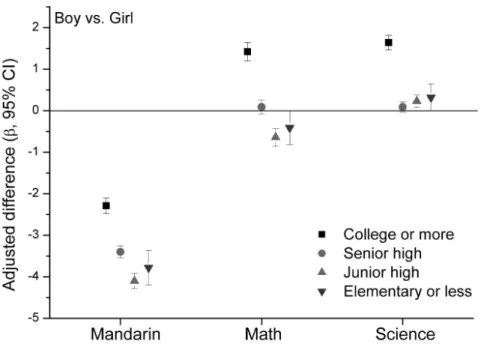Title: Effect-modification by parental education on the associations of birth order and gender with learning achievement in adolescents Running title: Effects of birth order and gender on learning
achievement
Authors’ names and affiliations:
C.-C. J. Cheng,* W.-L. Wang,†‡ Y.-T. Sung,§ Y.-C. Wang, ¶ S.-Y. Su,** C.-Y. Li ††‡‡ * Department of Public Health, College of Medicine, Fu-Jen Catholic
University, New Taipei City, Taiwan
† Department of Medical Research, Buddhist Tzu Chi General Hospital, Hualien, Taiwan
‡ Department of Health Promotion and Health Education, National Taiwan Normal University, Taipei, Taiwan
§ Research Center for Psychological and Educational Testing and Department of Educational Psychology and Counseling, National Taiwan Normal University, Taipei, Taiwan
¶ Department of Bioenvironmental Engineering, Chung Yuan Christian University, Taoyuan, Taiwan
** Division of Gastroenterology, Department of Medicine, Sin-Lau Hospital, Tainan, Taiwan
†† Department and Graduate Institute of Public Health, College of Medicine, National Cheng Kung University, Tainan, Taiwan
‡‡ Department of Public Health, College of Public Health, China Medical University, Taichung, Taiwan
Department of Medicine, Sin-Lau Hospital The Presbyterian Church
57, Eastgate Rd. Sec 1, Tainan, Taiwan 70142
Word count: 3,393 Keywords:
birth order, gender difference, academic achievement, educational level, educational psychology
Title: Effect modification of parental education on the associations
of birth order and gender with learning achievement among adolescents
Abstract
Background A child’s gender and ordinal position within a family have varied implications on his or her personality and cognitive development. However, little is known about whether or not parental educational level may moderate the effects of birth order and gender.
Methods Basic Competence Test (BCT) scores of 290,588 young adolescents aged 15 to 16 years in Taiwan were analyzed. Parental educational level was calculated as the highest educational attainment of the subjects’ parents. The multiple linear regression model was employed to assess the modification effects of parental educational levels on the associations of interest.
Results After controlling for covariates, we noted a clear inverse relationship between birth order and BCT scores in Mandarin, Mathematics, and Science. Additionally, boys had significantly lower mean scores in Mandarin, but had significantly higher mean scores in both Mathematics and Science. We also found the significant interactive effects of birth order, gender, and parental educational
attainment on BCT scores, in which the birth order and gender effects were more evident in higher-educated families than in lower-educated ones.
Conclusions This large cohort study confirmed that both birth order and gender may pose independent influences on BCT scores; moreover, such influences are significantly modified by parental educational attainment.
Introduction
Past studies have shown that children’s birth order position and gender have a substantial influence on their intellectual development. However, few of these managed to examine how socio-economic factors, such as parental education, may moderate gender and birth order effects on intelligence or academic outcomes.
Belmont and Marolla (1973) first reported the negative correlation between birth order and intelligence among Dutch men, and since then, several subsequent have studies confirmed their findings (Cherian 1990; Sputa & Paulson 1995; Paulhus et al. 1999; Bjerkedal et al. 2007; Boomsma et al. 2008; Kirkcaldy et al. 2009; Zambrana et al. 2012). Two theoretical models have been proposed to explain birth order effects: the confluence theory (Zajonc and Markus 1975) and the dilution theory (Blake 1981). The former states that a family’s intellectual environment declines as more children are born to it; however, the early born may benefit from tutoring their younger siblings, especially in their verbal development. The latter, meanwhile, highlights the dilution of parental resources distributed to the later born. Parents’ resources are finite; families with large sibship size may suffer from reduced resources allocated to each child, especially the latter born. Nonetheless, some argue that such a relationship might be false,
especially family size and socio-economic background, such that disadvantaged families tend to have more children, resulting in the poor performance of children with higher birth positions in intellectual tests (Abdel-Khalek & Lynn 2007; Rogers 2001; Rogers et al. 2000; Wichman et al. 2006).
We argue that birth order effects on intelligence may not be consistent across different parental educational levels. Parental education is a key factor affecting children’s academic outcomes (Brown & Iyengar 2008). Parents who are highly educated may value education more than those who are less educated, thus investing more resources, both financially and psychologically, in their children’s education. Highly educated parents may also be better at arranging the home environment in a way that is conducive to learning. Children of highly educated parents may have better cognitive competence. Downey (2001) argues that families vary in terms of the amount of resources readily distributed to their children. In disadvantaged families, the additional siblings probably have no effect on resource distribution because their parents have little to offer. It is possible that in less-educated families, parental resource is so limited that the advantage of being early born is compromised; hence, the inverse relationship between birth order and academic achievement may disappear. Although Downey points out that heterogeneity exists in the association between birth order and education outcomes across contexts, there is insufficient evidence to support this notion.
One study conducted by Bjerkedal and others (2007) provides a certain degree of support. They find that birth order differences in IQ scores between first-born and second-born children increase significantly with levels of maternal education. However, the mean difference between the second-born and the third-born is not affected by the mother’s educational level. Similarly, the mean IQ difference between the first-born and the second-born increases as the father’s income level increases. They argue that the magnitude of birth order effects might vary over changing contexts and that parents tend to invest more in the first-born. Although Bjerkedal and others (2007) indicate the moderating effect of maternal education on birth order effects, it is not clear if their study could be replicated. Zambrana and others (2012), meanwhile, find that maternal education significantly interacts with birth order to affect young children’s performance in language comprehension. However, they failed to report how the two variables interacted. Further research is needed to examine how parental education may moderate the birth order effects in a different population and in a different cultural context.
Cumulated studies have indicated that boys score higher in Science and Mathematics tests, while girls score higher in language tests (Frederickson & Petrides 2008; Lupart et al. 2004; Lu 2007; Lu & Mao 2008; Raag et al. 2011; Zambrana et al. 2012). Gender differences in academic performance may result from both biological
example, males and females may differ in their mental abilities or cognitive functioning. Males display higher efficacy in solving visuospatial and mathematical tasks, whereas females display higher efficacy in solving verbal tasks. These differences are found cross-culturally (Halpern & LaMay 2000; Neubauer et al. 2005; Lu 2007). In addition, girls generally have a more positive attitude toward schoolwork and greater intrinsic motivation to learn (Lupart et al. 2004). Further studies have also found that girls score higher in perceived capability and confidence in language, whereas boys score higher in perceived capability and confidence in Science and Mathematics (Chu 2002; Lupart et al. 2004; Drukker et al. 2009).
Past research, however, indicated that the socio-environmental influences on boys’ and girls’ learning performance vary. Social deprivation seemed to be more harmful for boys than for girls. Wood and others (2007) find that low socio-economic status renders African-American boys, but not girls, consistently at risk of school failure. McGraw et al. (2006) demonstrate that the gender gap in mathematics favoring boys is most consistent among white and high socio-economic status students. Examining a sample of toddlers, Zambrana and others (2012) find that gender differences in language comprehension increase with a decreasing level of maternal education, and that having a highly educated mother contributes more to the increase in language comprehension among boys than among girls. It seems that a high level of parental education or a high socio-economic background is a protective
factor in boys’ learning performance. These studies’ findings imply that gender might interact with socio-economic factors (e.g., parental education) to influence academic outcomes. We are interested to know how parental education may moderate gender difference in learning outcomes and see if past findings can be valid in different cultural contexts.
Specifically, we aim to determine how parental education may moderate the gender and birth order effects on Taiwanese adolescents’ academic performance in three subjects: Mandarin, Science, and Mathematics.
Methods
Study subjects
Between September 1, 1989 and August 31, 1990, there were 312,335 live singletons registered in the Taiwan Birth Registry (TBR). We first excluded 30 records with missing information on birth order or gender. Among the remaining singletons (N=312,305, i.e., the study population), 42.9% are first births. The corresponding figures for the second, third, fourth, and fifth or higher births were 35.9%, 16.3%, 3.6% and 1.1%, respectively. The TBR regulation requires all live births to be registered within 10 days following the birth. The data were systematically investigated against hospital obstetric records, and were considered valid and complete (Lin et al. 2004; Chen et al., 2010).
The Basic Competence Test (BCT)
All junior high school students in Taiwan are required to take the BCT during their last school semester (15 or 16 years of age). The test results are used by public senior high schools to enlist their future students. For the BCT scoring algorithm, the probability for a student to correctly answer a test item follows the binomial distribution, and the variability of the individual’s learning achievement level is assumed to follow a beta-binomial distribution, with which the probability of answering x items correctly for all examinees can be calculated (Kolen et al. 1992). Given that the measurement error
could vary with raw scores, the arcsine transformation is used to convert the raw scores and equalize the measurement errors (Freeman & Tukey 1950). With the probability of answering x items correctly and the transformed scores, the standardized score can be calculated with a mean of 30 and a range of 0 to 60.
The linkage between TBR and BCT datasets
Using a unique personal identification number, we linked the study cohort to the BCT dataset for the students who graduated in 2005. The linkage was successful for 124,826 first births; 104,753 second births; 47,397 third births; 10,500 fourth births; and 3,112 fifth or higher births, with the highest (92.3%) and the lowest (88.3%) follow-up rate noted for the second and the fifth or higher births, respectively. Table 1 shows the characteristics of the study subjects with a successful linkage to the BCT database. The study subjects with a failure linkage can be attributed to various reasons, including early death, taking the test in earlier or later years, enrolment in private schools, or immigration.
Statistical analysis
A multiple linear regression model was employed to calculate the adjusted BCT scores in Mandarin, Mathematics, and Science for the male subjects and those with a birth order of four or fewer compared with the reference groups (i.e., girls or subjects with a birth order of five or higher). The model simultaneously included
birth order, gender, season of birth, parents’ marital status at birth, current residence area, parents’ highest educational attainment, and parental age at birth in the equation.
To assess the significance of effect-modification of parents’ highest educational level on the effect of lower birth order (or boy subjects) on the BCT scores, we fitted the interaction term of parental educational level and birth order (or gender) into the regression models, after which we tested the significance of the regression coefficient of the interaction term. The results revealed that parental highest education has significant (p<0.001) interactive effect on both birth order and gender. Therefore, we graphically present the adjusted differences in BCT scores associated with birth order (or gender) according to parents’ highest educational level. All statistical tests are two-sided, and a p-value <0.05 was considered statistically significant. The data management and statistical analyses were performed using SPSS software (version 17.0, SPSS Inc.; Chicago, Illinois). Access to and analyses of data used in our study were approved by the Research Ethics Review Committee of the Research Center for Psychological and Educational Testing.
Results
The first and the second births consisted of nearly 80% of the study sample, whereas only 1.1% of the sample represented the fifth and higher births. Boys slightly dominated the study sample. Most of the study subjects (46.6%) were born to mothers aged 25 to 29 years old. We used the higher educational level of the father or the mother to indicate the parental educational level of a family, and noted that fathers had higher education than mothers in 11.15% of the families; 85.41% had fathers and mothers with equal educational levels; and 3.44% had fathers who were lower educated than mothers (data not shown). The majority (44.7%) of the sample had a parental educational level of senior high school, followed by junior high school (27.4%) (Table 1).
Table 2 presents the birth order-specific and gender-specific BCT scores. The data showed a decreasing trend in mean scores as birth order advanced. For the gender-specific scores, we noted that boys, compared with girls, had lower mean scores in Mandarin, but higher mean scores in Mathematics and Science.
Similar results were found after covariates were adjusted in the multivariate regression model (Table 3). The first births had the most increased score (8.24 points) in Mathematics. The increased scores for Mandarin and Science were 8.15 and 6.33, respectively. In addition, the discrepant scores between two adjacent births were
greater in lower births than in higher births for all three subject areas. For instance, in Mathematics, the discrepant scores between the first and second births and between the second and third births were 2.59 and 2.48, respectively; the discrepant scores between the third and fourth births and between the fourth and the 5th and higher births were 1.70 and 1.47, respectively.
The covariate-adjusted gender difference in scores showed that boys had a significantly lower mean score than girls in Mandarin (=-3.37 points, 95% CI: -3.46, -3.27), although their scores in Mathematics (=0.16 points, 95% CI: 0.05, 0.27) and Science (=0.85 points, 95% CI: 0.77, 0.93) were significantly higher.
Table 4 shows the adjusted difference in scores for Mandarin in relation to birth order and gender according to parental educational levels. Meanwhile, Table 5 and Table 6 show the adjusted results for Mathematics and Science, respectively. The birth order effect was observed across all parental educational levels. The differences in mean scores in Mandarin between the first and the fifth and higher births were greater for subjects with higher parental educational levels (8.83 for college or more, and 9.21 for senior high school) than for those with lower parental educational levels (7.31 and 6.58 points for junior high and elementary or less, respectively). Similar patterns were observed for scores in Mathematics and Science (Table 5, Table 6, and Figure 1).
gender differences in the three subject areas revealed that the gender-difference in Mandarin was less evident among the subjects with parental education of college or more (-2.29) than among those with lower parental educational attainment (-3.40 to -4.10 s) (Table 4 and Figure 2). Conversely, the gender differences in Mathematics and Science were more evident in the subjects with a parental educational level of college or more (1.42 in Mathematics, 9 times enlarged; 1.64 in Science, 2 times enlarged) than for those with lower parental educational attainment. In the lowest parental educational level, gender difference in Science no longer existed. Moreover, in two lower parental educational levels (i.e., junior high and elementary or less), boys scored lower than girls in Mathematics (Table 5, Table 6, and Figure 2).
Discussion
Birth order, parental education, and learning outcomes
The birth order effect was evident among Taiwanese adolescents in all three subject areas, indicating a decrease in mean scores as birth orders advanced. The findings are consistent with those of many past studies (Cherian 1990; Sputa & Paulson 1995; Paulhus et al. 1999; Bjerkedal et al. 2007; Boomsma, et al., 2008; Kirkcaldy et al. 2009; Zambrana et al., 2012). We also discovered that such an inverse relationship between birth order and academic outcomes consistently held for all parental educational levels.
However, since we argued that parental education may moderate the birth order effects, we also found that the discrepancies between the first and the fifth and higher births were enlarged in families with higher parental educational levels, but were reduced in families with lower parental education levels. This phenomen on held remarkably for all three subject areas (Figure 1). To a certain extent, the result is consistent with that of Bjerkedal and others (2007), who find that birth order difference in IQ scores increases significantly with higher levels of maternal education, but only between the first and the second born. Our study was extended to show that the moderating effect of parental education may apply to a broader range of birth order pairs, between the first and the fifth and higher births, and also to different subject areas. If the birth order effect is a consequence of parental resource distribution, as argued by Blake (1981) and Downey (2001), low er -educated parents may have less to offer to their children than their highly educated counterparts, resulting in reduced magnitude of birth order effect on academic outcomes among siblings in such families. The results of our study partly support the resource dilution model (Blake, 1981) as well as the contention that there are variations in the magnitude of birth order effect over changing contexts as posited by Downey (2001) and Bjerkedal and others (2007). Nevertheless, Bjerkedal and others (2007) also argued that mothers tended to invest more in first-born children. Our finding also somewhat concurred with their argument. We found that the magnitude of score difference between
two adjacent births decreased from lower to higher births; moreover, the case held for all three subject areas. Parental resource favoring the firstborn might be due to resource limitation and a cultural norm that values the firstborn. However, these explanations are certainly open to future investigations.
Although our study provided some support to the moderation effects of parental education, the inverse relationship between birth order and learning outcomes still held across all parental education levels, even in the lowest one. The early birth still seemed superior in intellectual development. This could be interpreted in support of the confluence model (Zajonc & Markus, 1975), which highlights the effects of changing family dynamics on a child’s intellectual development as a function of sibship size. The intellectual environment becomes discouraging when more children are born to a family. Our study supports this notion in that the depressing intellectual environment might occur in the context of all parental educational levels. In addition, the largest discrepancy between two adjacent births was observed between the first and second births in terms of performance in Mandarin. This finding can also be explained according to the confluence model, which states that tutoring practices may benefit the first born in their verbal abilities. However, further research is needed to see if our finding can be replicated.
components of family interactions resulting in variations of birth order effects at different parental education levels. For example, past studies have found that highly educated parents tend to have high educational expectations for their children, resulting in high academic achievements ( Brown & Iyengar, 2008 ). It is likely that parents may have higher educational expectations for the early born than the later born, since it is their first experience of parenthood, and they might expect their children to perform well at school. This might be especially true for highly educated parents, since they might value education more than their less-educated peers.
Gender, parental education, and learning outcomes
Consistent with previous findings, we found that girls scored higher in Mandarin (a language subject), whereas boys scored higher in Mathematics and Science. However, when considering parental education, there was a trend for boys to do better in families with the highest parental education (college level), but do worse in families with lower parental education in all three subject areas (Figure 2). Gender effects were more evident in higher-educated families than in lower-educated ones. For example, the gender difference in Mandarin was largely lessened in the highest parental education level; boys scored worse than girls in Mathematics in the two lowest parental education levels; and the gender difference in Science was lessened at lower parental education levels. These results provide some support to the notion that boys might be more
vulnerable to a disadvantaged environment and could benefit from a better socio-economic environment (e.g., Cook et al., 1996; Entwisle et al. 2007; Zambrana et al., 2012). As suggested previously, highly educated parents might be better at providing educational resources to their children. Parental resources tend to favor boys over girls in most Asian cultures ( Hou & Leung 2011; Lee 2009). In families of highly educated parents, this might contribute partly to boys’ acceleration in learning performance, especially in subjects such as Mathematics and Science, where they generally showed better cognitive strength.
Another explanation comes from the differential influences of fathers and mothers on their children’s learning outcomes. In Taiwan, fathers generally have greater decision-making authority than mothers. Yang (1994), for example, discovered that the father’s educational expectation toward children influenced the latter’s self-expectation. In our sample, about 97% of families had fathers whose educational levels were higher than or equal to the mothers’ educational levels. Cook et al. (1996) suggests that a highly educated father serves as a role model for boys to identify with academically. Highly educated fathers also exert greater influence on their boys than on their girls, thereby enhancing boys’ academic performance. However, more gendered familial interactions, such as gender-based roles and other factors that may vary in different parental educational levels should be examined to determine the
in learning outcomes.
Although this study considered a comprehensive list of potential confounders, there is a lack of information on family size in our dataset. Although we controlled for other confounding variables possibly associated with family size, such as maternal age at birth (high maternal age might mean having more children), birth location (mothers living in the southern and eastern parts of Taiwan tended to have more children), and so on, they are only proxies for family size. Although the variables we had controlled for effectively captured most of the between-family confounding variances, interpretations of findings regarding birth order effects are limited. In addition, the modification effects found in our study referred only to those associated with parental educational levels. Furthermore, our results were based on a population of Taiwanese adolescents. Future research into other cultures is needed to further confirm the findings.
Conflict of interest statement
No conflict of interest
Acknowledgments
This study was partially supported by a grant from the National Scientific Council (NSC 98-2314-B-227-001-MY2).
A child’s gender and ordinal position within a family have varied implications on his or her cognitive development.
Parental education al level may have a significant impact on learning achievement among children and adolescents.
Limited information is available concerning whether or not parental education al level may moderate the influence of one’s birth order and gender on learning achievement .
This study found that the birth order and gender effects on young adolescents’ learning achievement were more evident in higher-educated families than in lower-educated ones.
Intervention strategies that aim to reduce the birth order or gender inequality in learning achievement among young adolescents have to consider the parents’ educational level.
References
Abdel-Khalek, A. M. & Lynn, R. (2007) Intelligence, family size and birth order: some data from Kuwait. Personality and Individual Differences, 44, 1032-1038.
Blake, J. (1981) Family size and the quality of children. Demography, 18, 421-442.
Belmont, L. & Marolla, F. A. (1973) Birth order, family size, and intelligence. Science, 1982, 1096-1101.
Intelligence test scores and birth order among young Norwegian men (conscripts) analyzed within and between families.
Intelligence, 35, 503-514.
Boomsma, D. I., Beijsterveld, T., Beem, A. L., Hoekstra, R. S., Polderman, T., Bartels, M. (2008). Intelligence and birth order in boys and girls. Intelligence , 36 , 630-634.
Chu, Y. W. (2002) The relationships between domain-specific self-concepts and global self-esteem among adolescents in Taiwan. Bulletin of Educational Psychology, 33, 104-123.
Chen, C. W., Tsai, C. Y., Sung, F. C., Lee, Y. Y., Lu, T. H., Li, C. Y., & Ko, M. C. (2010) Adverse birth outcomes among teenage pregnancies: age-specific analysis of national data in Taiwan. Child: Care,
Health & Development, 36:232-240.
Cherian, V. I. (1990) Birth order and academic achievement of children in Transkei. Psychological Reports, 66, 19-24.
Cook, T. D., Church, M. B., Ajanaku, S., Shaish, W. R., Kim, J., &
Cohen, R. (1996) The development of occupational aspiration and expectations among inner-city boys. Child Development, 67, 3368-3385.
Drukker, M., Feron, F. J. M., & OS, J. V. (2009) Neighborhood
socioeconomic and social factors and school achievement in boys and girls. The Journal of Early Adolescence, 29, 285-306.
Entwisle, D. R., Alexander, K. L., & Olson, L. S. (2007) Early schooling: the handicap of being poor and male. Sociology of Education, 80, 114-138.
Frederickson, N. & Petrides, K. V. (2008) Ethnic, gender, and socio-economic group differences in academic performance and
secondary school selection: a longitudinal analysis. Learning and Individual Differences, 18, 144-151.
Freeman, M.F. & Tukey, J. W. (1950). Transformations related to the angular and square root. The Annals of Mathematical Statistics, 21, 607-611.
Freudenthaler, H. H., Spinath, B., & Neubauer, A. C. (2008)
Predicting school achievement in boys and girls. European Journal of Personality, 22, 231-245.
Halpern, D. F. & LaMay, M. L. (2000) The smarter sex: a critical review of sex differences in intelligence. Educational Psychology Review, 12, 229-246.
Hou, Z-J & Leung, S. A. (2011). Vocational aspirations of Chinese
high school students and their parents’ expectations. Journal of Vocational Behavior, 79 , 349-360.
Kolen, M. J., Hanson, B. A., & Brennan, R. L. (1992) Conditional standard errors of measurement for scale scores. Journal of Educational Measure, 29, 285-307.
Kirkcaldy, B., Furnham, A., & Siefen, G. (2009) Intelligence and birth order among children and adolescents in psychiatric care. School Psychology International, 30, 43-55.
Lin, C. M., Lee, P. C., Teng, S. W., Lu, T. H., Mao, I. F., & Li, C. Y. (2004) Validation of the Taiwan birth registry using obstetric records. Journal of the Formosan Medical Association, 103, 297-301.
Lee, K. S. (2009). Competition for resources: A reexamination of
sibship composition models of parental investment. Journal of Marriage and Family, 71 , 263-277.
Lu, S. M. & Mao, G. N. (2008) Investigation of the gender differences and differential item functioning in Science Basic Competence Test for junior high school students. Journal of Education Practice and Research, 21, 95-125.
Lu, S.M. (2007) Investigation of the gender differences and differential item functioning on Chinese and English Basic Competency Test for junior high school students. Journal of Educational Research and Development, 3, 79-111.
Lupart, J. L., Cannon, E., & Telfer, J. A. (2004) Gender differences in adolescent academic achievement, interests, values and life-role expectations. High Ability Studies, 15, 25-42.
McGraw, R., Lubienski, S. T., & Strutchens, M. E. (2006) A closer look at gender in NAEP mathematics achievement and affect data: Intersections with achievement, race/ethnicity, and
socioeconomic status. Journal of Research in Mathematics Education, 37, 129-150.
Neubauer, A. C., Grabner, R. H., Fink, A., & Neuper, C. (2005) Intelligence and neural efficiency: further evidence of the influence of task content and sex on the brain-IQ relationship. Cognitive Brain Research, 25, 217-225.
Paulhus, D. L., Trapnell, P. D., & Chen, D. (1999) Birth order effects on personality and achievement within families. Psychological Science, 10, 482-488.
Raag, T., Kusiak, K., Tumilty, M., Kelemen, A., Bernheimer, H., & Bond, J. (2011). Reconsidering SES and gender divides in literacy achievement: Are the gaps across social class and gender
necessary? Educational Psychology , 31 , 691-705.
Rogers, J. L. (2001) What causes birth order-intelligence patterns? The admixture hypothesis, revived. American Psychologist, 56, 505-510.
Rogers, J. L., Cleveland, H. H., van den Oord, E., & Rowe, D. C. (2000) Resolving the debate over birth order, family size, and intelligence, American Psychologist, 55, 599-612.
Sputa, C. L. & Paulson, S. E. (1995) Birth order and family size: Influences on adolescents’ achievement and related parenting behaviors. Psychological Reports, 76, 43-51.
Wood, D., Kaplan, R., & McLoyd, V. C. (2007) Gender differences in the educational expectations of urban, low-income African
American youth: the role of parents and the school. Journal of Youth and Adolescence, 36, 417-427.
Wichman, A. L., Rodgers, J. L., & MacCallum, R. C. (2006) A
multilevel approach to the relationship between birth order and intelligence. Personality and Social Psychology Bulletin, 32, 117-127.
Yang, Y. (1994) The educational opportunities of children in Taiwan. Educational Research & Information, 2, 1-22.
Zajonc, R. B. & Markus, G. B. (1975) Birth order and intellectual development. Psychological Review, 82, 75-88.
Zambrana, I. M., Ystrom, E., & Pons, F. (2012). Impact of gender, maternal education, and birth order on the development of language comprehension: A longitudinal study from 18 to 36 months of age. Journal of Developmental and Behavioral Pediatrics , 33 , 146-155.
Table 1. Characteristics of the study subjects (N=290,588) Characteristics n % Birth order 1 124,826 43.0 2 104,753 36.0 3 47,397 16.3 4 10,500 3.6 >=5 3,112 1.1 Gender Boy 151,398 52.1 Girl 139,190 47.9 Season of birth March-May 72,168 24.8 June-August 77,298 26.6 September-November 69,109 23.8 December-February 72,013 24.8
Maternal age at birth (year)
<20 9,519 3.3
20-24 73,659 25.4
25-29 135,065 46.6
30-34 58,672 20.2
≧35 12,837 4.4
Paternal age at birth (year)
<20 2,166 0.8
20-24 22,173 7.8
25-29 116,225 40.7
30-34 105,366 36.9
≧35 39,901 14.0
Birth weight (gram)
<2500 10,955 3.8
>=2500 277,428 96.2
Gestational age (week)
<37 9,498 3.3
attainment of parents
Elementary or less 17,309 6.0
Junior high 79,580 27.4
Senior high 129,913 44.7
College or more 63,719 21.9
Parent’s marital status
Married 283,231 97.8 Unwedded 6,292 2.2 Residence area North 122,926 42.3 Central 79,726 27.4 South 80,327 27.6
East and remote islands 7,608 2.6
Note: Inconsistency between total population and population summed for individual variable was due to missing information
Table 2. Mean BCT scores on three selected disciplines according to
birth order and gender
Group Mandarin Mathematics Science
X SD X SD X SD Birth order 1 31.8 14.1 31.6 16.4 31.4 12.2 2 30.1 14.3 30.4 16.6 30.1 12.2 3 27.1 14.2 27.2 16.4 27.7 11.8 4 24.7 13.9 24.1 16.1 25.5 11.3 >=5 22.2 14.0 20.9 15.6 23.7 10.8 Gender Boy 28.5 14.8 30.2 17.4 30.4 12.8 Girl 31.8 13.6 30.0 15.7 29.5 11.6 Total 29.8 14.5 29.6 14.5 29.7 13.5
Table 3. Adjusted differences (β) and 95% confidence intervals (CI) of BCT scores in relation to birth order and
gender
Group Mandarin Mathematics Science
β (95% CI) β (95% CI) β (95% CI)
Birth order
1 8.15 (7.66, 8.65) 8.24 (7.66, 8.82) 6.33 (5.91, 6.76)
2 5.14 (4.64, 5.63) 5.65 (5.07, 6.23) 3.94 (3.52, 4.36)
3 2.73 (2.23, 3.22) 3.17 (2.59, 3.75) 1.99 (1.57, 2.41)
4 1.37 (0.84, 1.91) 1.47 (0.84, 2.10) 0.80 (0.34, 1.26)
>=5 Reference Reference Reference
Gender
Boy -3.37 (-3.46, -3.27) 0.16 (0.05, 0.27) 0.85 (0.77, 0.93)
Girl Reference Reference Reference
Note: Differences in BCT scores were estimated from multiple linear regression models with adjustment for season of birth, parental marital status, residential area, the highest educational attainment of parents, parental ages at the time of delivery, birth weight, and gestational age.
Table 4. Adjusted differences (β) and 95% confidence intervals (CI) of mandarin score in relation to birth order
and gender according to the highest educational attainment of parents
Group College or more Senior high Junior high Elementary or less
β (95% CI) β (95% CI) β (95% CI) β (95% CI) Birth order 1 8.83 (6.74, 10.92) 9.21 (8.09, 10.33) 7.31 (6.42, 8.20) 6.58 (5.66, 7.50) 2 5.94 (3.86, 8.03) 6.05 (4.93, 7.17) 4.40 (3.52, 5.28) 4.21 (3.34, 5.09) 3 3.10 (1.00, 5.19) 3.41 (2.29, 4.53) 2.52 (1.63, 3.40) 2.94 (2.09, 3.79) 4 0.51 (-1.73, 2.75) 1.87 (0.68, 3.06) 1.13 (0.18, 2.07) 2.15 (1.23, 3.07) >=5 Reference Referenc e Referenc e Referenc e
Gender Boy -2.29 (-2.48, -2.11) -3.40 (-3.55, -3.26) -4.10 (-4.29, -3.92) -3.78 (-4.19, -3.36) Girl Reference Referenc e Referenc e Referenc e
Table 5. Adjusted differences (β) and 95% confidence intervals (CI) of mathmatics score in relation to birth order
and gender according to the highest educational attainment of parents
Group College or more Senior high Junior high Elementary or less
β (95% CI) β (95% CI) β (95% CI) β (95% CI) Birth order 1 9.47 (6.99, 11.94) 9.33 (8.01, 10.66) 7.17 (6.15, 8.19) 6.70 (5.68, 7.73) 2 7.18 (4.71, 9.66) 6.61 (5.29, 7.93) 4.52 (3.50, 5.53) 4.58 (3.60, 5.56) 3 4.19 (1.70, 6.67) 3.95 (2.62, 5.27) 2.58 (1.56, 3.59) 3.43 (2.48, 4.37) 4 1.48 (-1.18, 4.13) 2.20 (0.79, 3.61) 0.74 (-0.34, 1.83) 2.32 (1.29, 3.34) >=5 Reference Referenc e Referenc e Referenc e Gender Boy 1.42 (1.20, 0.09 (-0.08, -0.64 (-0.86, -0.41
(-0.87,-1.64) 0.26) -0.43) 0.06) Girl Reference Referenc e Referenc e Referenc e
Table 6. Adjusted differences (β) and 95% confidence intervals (CI) of science score in relation to birth order and
gender according to the highest educational attainment of parents
Group College or more Senior high Junior high Elementary or less
β (95% CI) β (95% CI) β (95% CI) β (95% CI) Birth order 1 8.29 (6.34, 10.25) 7.24 (6.28, 8.21) 5.49 (4.78, 6.20) 4.57 (3.86, 5.29) 2 5.83 (3.88, 7.78) 4.73 (3.77, 5.69) 3.26 (2.56, 3.96) 2.89 (2.21, 3.57) 3 3.30 (1.34, 5.26) 2.66 (1.70, 3.63) 1.80 (1.10, 2.51) 1.94 (1.28, 2.60) 4 1.28 (-0.82, 3.37) 1.11 (0.09, 2.13) 0.69 (-0.07, 1.44) 1.33 (0.62, 2.05) >=5 Reference Referenc e Referenc e Referenc e Gender Boy 1.64 (1.47, 0.09 (0.77, 0.23 (0.08, 0.32 (-0.01,
1.82) 1.02) 0.38) 0.64) Girl Reference Referenc e Referenc e Referenc e
Figure 1. Adjusted differences in BCT scores among birth orders (5th and higher birth as reference group) according to parental
Figure 2. Adjusted differences in BCT scores between boys and girls (reference) according to parental educational level
